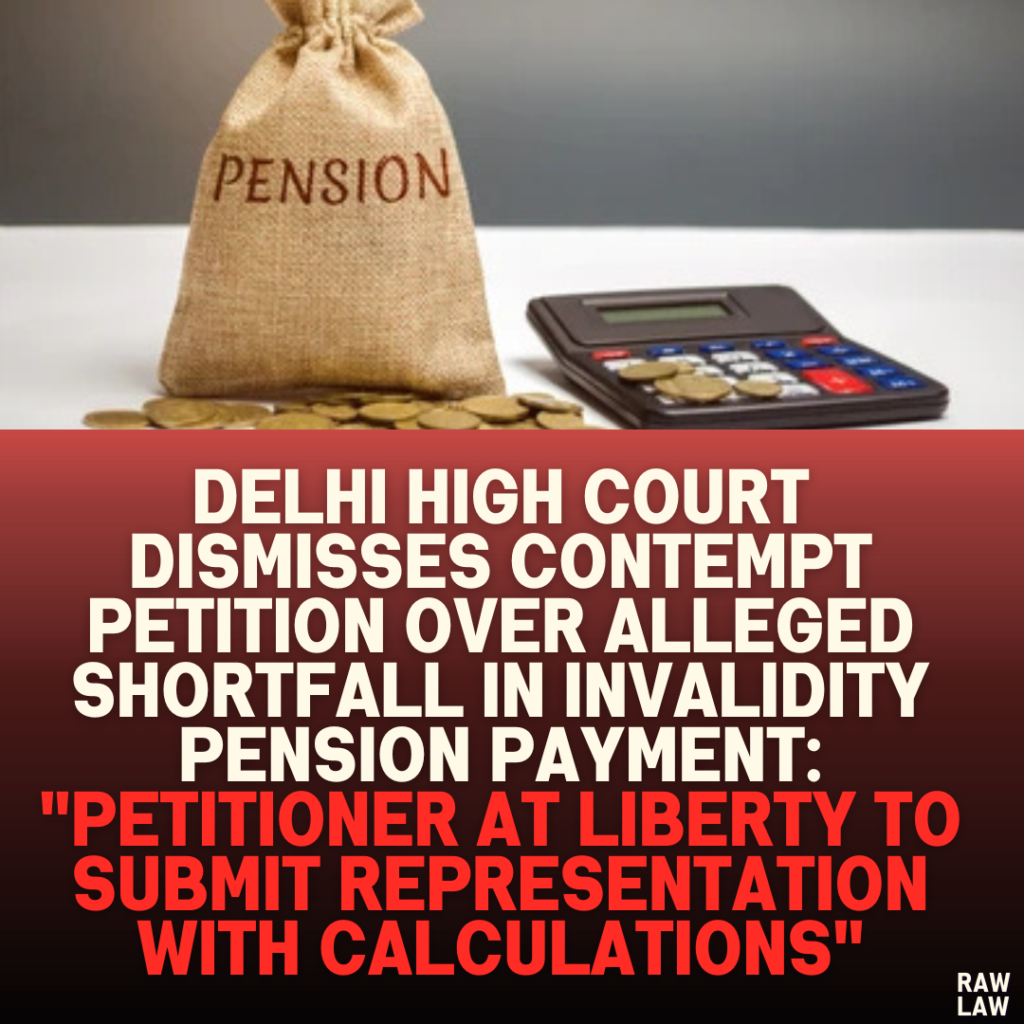Court’s Decision
The Delhi High Court dismissed the contempt petition, providing liberty to the petitioner to submit a representation with necessary calculations of the alleged shortfall in the invalidity pension payment. The court directed the respondent to handle the representation promptly and resolve any issues.
Facts
- Original Judgment:
- The petitioner had earlier filed W.P. (C) No. 3884/2010, in which the Delhi High Court ruled that he was entitled to invalidity pension with effect from July 15, 1993.
- The judgment specified payment with 6% interest per annum. If payments were not made within four weeks, the interest rate would increase to 10%.
- Compliance and First Contempt Petition:
- In compliance with the court’s directions, the respondent paid ₹19,12,477. This led to the withdrawal of the first contempt petition filed by the petitioner.
- Current Contempt Petition:
- The petitioner filed the current contempt petition, claiming the amount paid by the respondent was significantly less than his entitlement.
- The petitioner argued that he believed the earlier payment was full and final but later realized it was insufficient.
- Absence of Calculation Sheet:
- The petitioner did not attach a calculation sheet to substantiate his claim of shortfall, leaving the court without any tangible basis for determining the alleged discrepancy.
Issues
- Did the respondent fully comply with the court’s previous directions on the payment of invalidity pension?
- Was there a significant shortfall in the payment, as claimed by the petitioner, and did it amount to contempt of court?
Petitioner’s Arguments
- The petitioner asserted that the amount of ₹19,12,477 paid by the respondent was not in full compliance with the court’s earlier order.
- The filing of the contempt petition was aimed at ensuring enforcement of the original judgment.
Respondent’s Arguments
- Compliance with Directions: The respondent contended that they had fully complied with the court’s directions and paid the entire amount due.
- Dismissal of Review Petition: They highlighted that the petitioner had earlier sought a review for disability pension in addition to invalidity pension, which was dismissed by the Division Bench.
- Good Faith Gesture: The respondent, acknowledging the petitioner’s grievance, offered to entertain a representation from the petitioner specifying the shortfall and assured a prompt response.
Analysis of the Law
- Contempt Jurisdiction:
- For a finding of contempt, there must be deliberate non-compliance with a court order. In this case, the respondent asserted full compliance and showed willingness to address any perceived discrepancies.
- Invalidity Pension:
- The petitioner’s entitlement to invalidity pension, as per the original court order, was clear. However, any dispute about the calculation required precise documentation, which was absent here.
- Judicial Discretion in Contempt:
- The court, instead of penalizing the respondent, exercised discretion to ensure the issue could be resolved administratively through representation and discussion.
Precedent Analysis
The court relied on its own previous rulings in W.P. (C) No. 3884/2010 and the review petition order. These rulings formed the basis for determining compliance.
Court’s Reasoning
- Absence of Calculation Sheet:
- The petitioner did not provide evidence, such as a calculation sheet, to show how the amount paid was deficient or fell short of the directed payment.
- Respondent’s Compliance:
- The respondent demonstrated compliance by making the payment and providing a detailed explanation of the calculations in earlier proceedings.
- The respondent’s offer to entertain a representation showed good faith and negated any intentional non-compliance.
- Resolution Through Representation:
- The court acknowledged the respondent’s willingness to consider a detailed representation and encouraged the petitioner to utilize this avenue for resolution.
Conclusion
The court disposed of the contempt petition, granting the petitioner liberty to submit a representation within two weeks. It directed the respondent to process the representation expeditiously.
Implications
- Clarity in Compliance:
- The case underscores the importance of clear documentation when asserting non-compliance with court orders.
- It highlights the court’s focus on resolving disputes pragmatically rather than penalizing parties in the absence of willful disobedience.
- Administrative Resolution:
- The court emphasized resolving grievances through administrative means like representations, demonstrating a preference for collaborative over adversarial approaches.
- Reinforcement of Judicial Orders:
- The ruling reaffirms that compliance with judicial directions must be precise, and any ambiguity should be clarified through proper communication between parties.




Pingback: Jammu & Kashmir High Court Dismisses Challenges to Repealed Wakafs Act, Upholds Eviction Notices and Rent Revisions: “Statutory Remedies Must Be Exhausted Before Invoking Writ Jurisdiction” - Raw Law